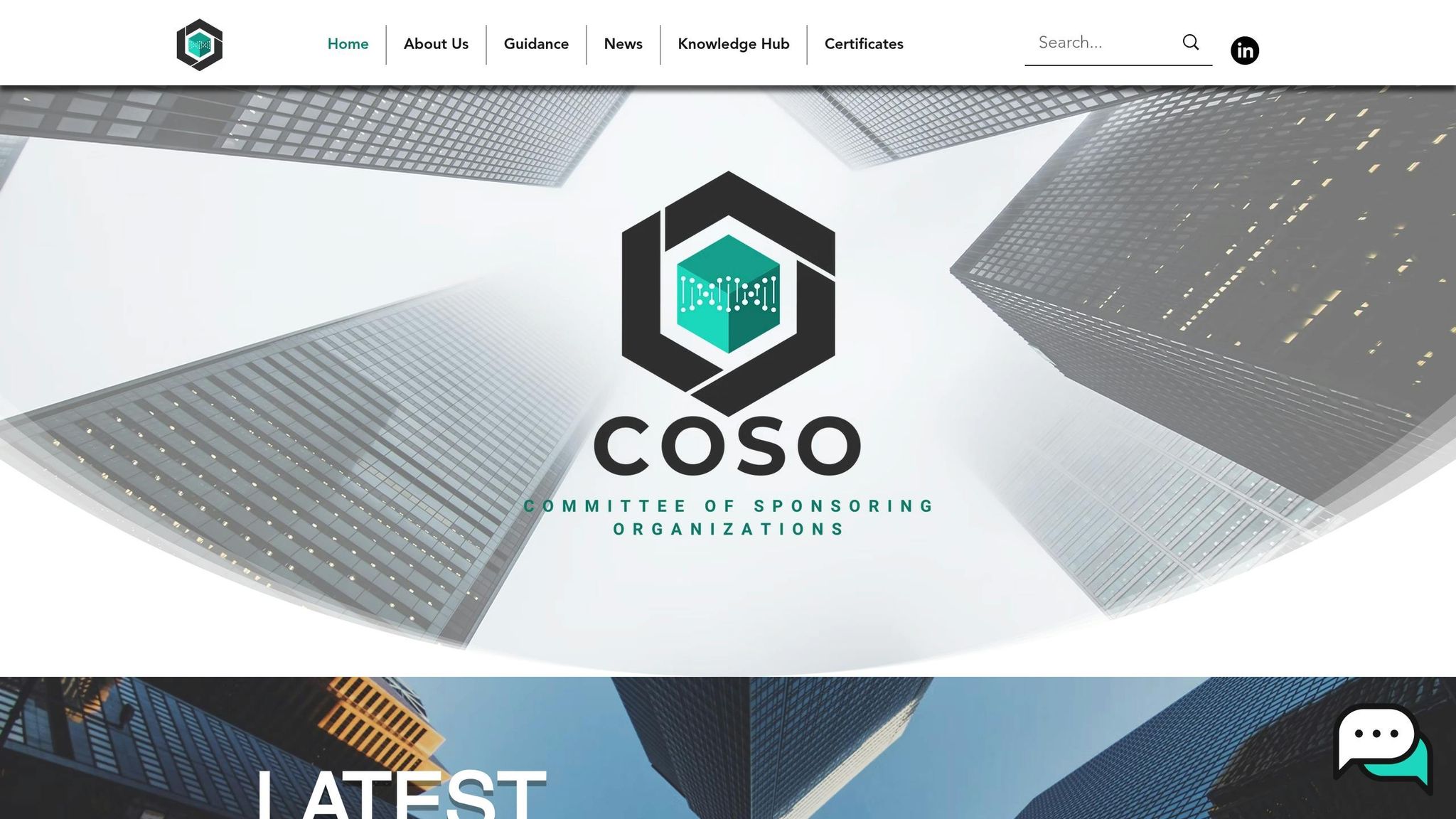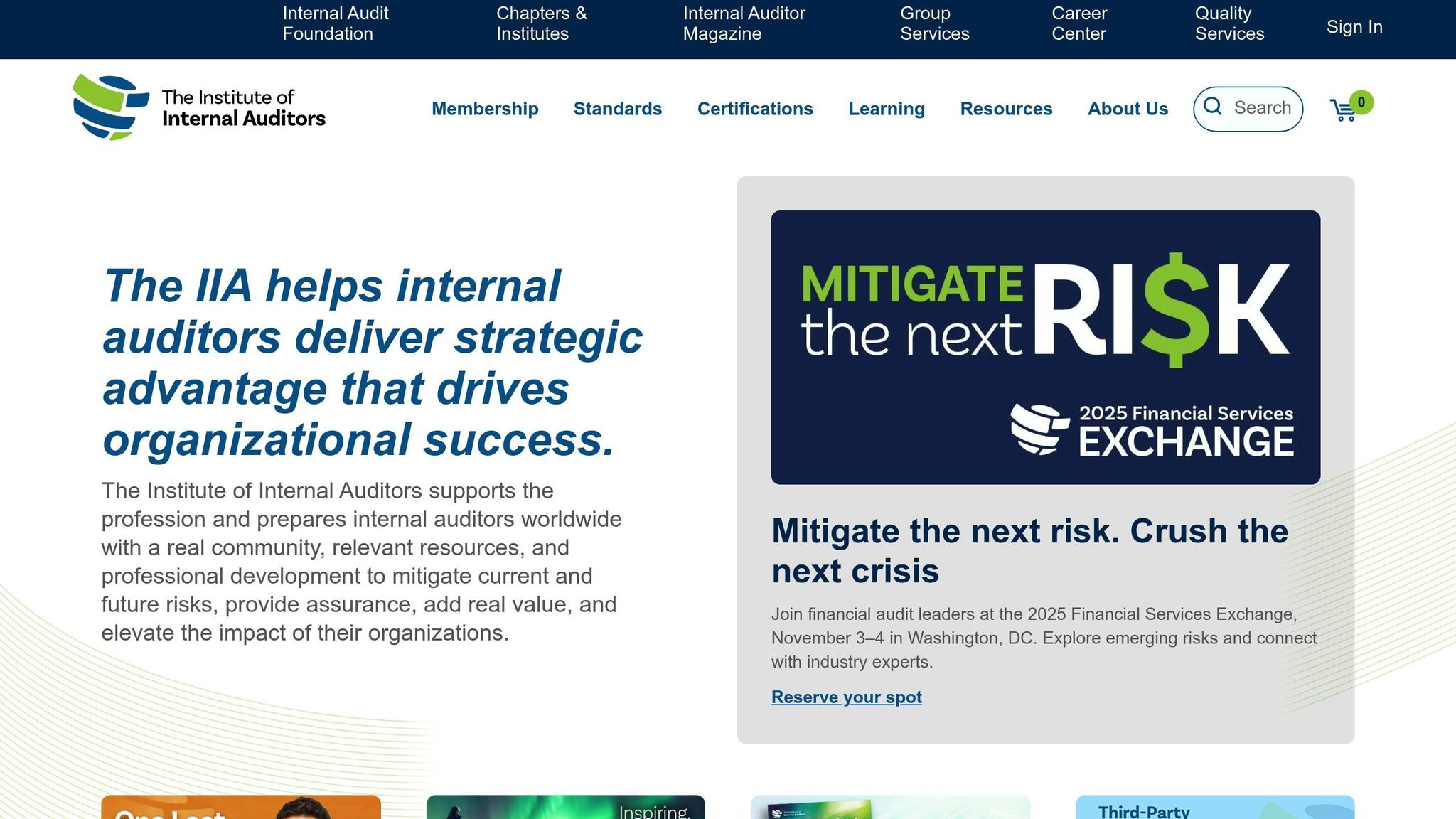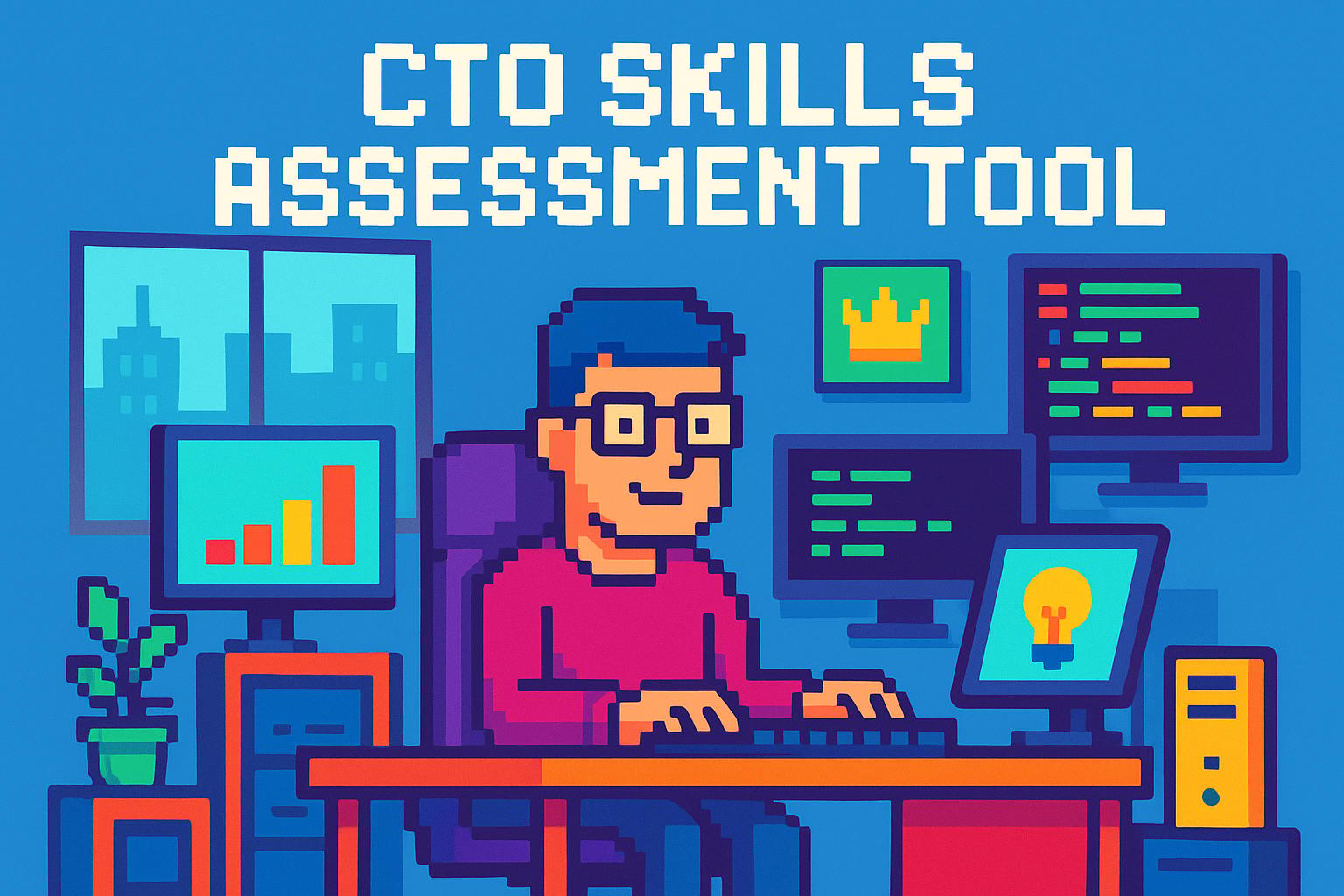5 AI Auditing Frameworks for Compliance
October 1, 2025



Artificial intelligence (AI) is transforming industries, but with it comes a maze of regulations and compliance challenges. As of 2025, 38 U.S. states have passed nearly 100 AI-related laws, and federal agencies like the FTC and EEOC are ramping up scrutiny. Non-compliance can lead to hefty fines, reputational damage, and operational setbacks. To tackle this, organizations are turning to AI auditing frameworks.
Here are five key frameworks to help businesses manage AI risks, ensure compliance, and maintain accountability:
- COBIT Framework: Focuses on IT governance and risk management, addressing issues like algorithmic bias and data security.
- COSO ERM Framework: Integrates AI risks into broader enterprise risk management, aligning them with strategic goals.
- GAO AI Accountability Framework: Prioritizes accountability and monitoring, with a focus on governance, data integrity, and performance.
- IIA AI Auditing Framework: Emphasizes ethical AI practices, internal audit involvement, and lifecycle oversight.
- S&P Global Essential Intelligence® Framework: Combines data analytics with governance to manage AI risks, particularly in finance and compliance-heavy sectors.
Each framework offers unique strengths, from IT-focused governance to enterprise-wide risk management. Selecting the right one depends on your industry, compliance needs, and governance maturity. Implementing these frameworks now can prepare your organization for evolving regulations and protect against potential risks.
Building Trustworthy AI with ISO/IEC 42001 and the NIST AI Framework

1. COBIT Framework

COBIT, originally designed for IT governance, has evolved into a versatile tool for managing and overseeing AI systems. AuditBoard describes it as:
COBIT (Control Objectives for Information and Related Technologies) isn't just an IT framework - it's the Swiss Army knife of governance [5].
This framework provides organisations with a structured way to manage AI systems throughout their lifecycle while addressing the unique challenges AI presents.
Governance and Risk Management
One of COBIT's strengths lies in its ability to establish clear ownership and accountability for AI initiatives. It ensures that every AI project has a designated sponsor, maintaining governance standards. Furthermore, its risk management capabilities are specifically designed to tackle AI-related threats like algorithmic bias, data poisoning, cyberattacks, and transparency issues. Through structured risk assessments (APO12) and alignment with an organisation's risk appetite (EDM03), COBIT helps mitigate these risks [1].
Consider a real-world example: In 2024, Air Canada faced a lawsuit after its AI chatbot provided inaccurate information about bereavement fares. A Canadian tribunal ruled against the airline, pointing to significant gaps in AI governance, particularly around accuracy, accountability, and oversight. COBIT’s risk management guidelines could have helped avoid this scenario by ensuring proper validation processes for AI-generated outputs [2]. By addressing such risks, COBIT also supports better regulatory compliance.
Compliance with Regulations
COBIT is an effective tool for navigating the increasingly complex landscape of AI regulations, such as the EU AI Act and GDPR. It provides clear guidance on meeting regulatory requirements through objectives like MEA03 (Managed Compliance with External Requirements) and APO14 (Managed Data), which focus on data quality and privacy [1]. Additionally, COBIT incorporates ethical principles into AI governance, promoting transparency, fairness, non-discrimination, and human oversight - key elements for regulatory compliance.
Organisations across various industries, including financial services, healthcare, and retail, are using COBIT to balance regulatory adherence with innovation. For instance, these sectors apply the framework to enhance risk management, detect fraud, improve patient care, and optimise customer analytics [4]. Beyond compliance, COBIT provides guidance for managing AI systems at every stage of their lifecycle.
AI System Lifecycle Monitoring
COBIT takes a comprehensive approach to AI governance, covering all phases of an AI system’s lifecycle across five key domains:
- Design Phase: The Evaluate, Direct, and Monitor (EDM) domain ensures AI initiatives align with strategic goals and embed ethical principles from the beginning.
- Development Phase: The Align, Plan, and Organize (APO) domain focuses on creating management structures, security policies, and data governance processes to address vulnerabilities like bias and security risks.
- Deployment Phase: The Build, Acquire, and Implement (BAI) domain ensures smooth system integration through rigorous testing, validation, and change management to minimise disruptions.
- Operations Phase: The Deliver, Service, and Support (DSS) domain oversees day-to-day operations, ensuring AI systems function efficiently and remain protected against cyberthreats.
- Monitoring Phase: The Monitor, Evaluate, and Assess (MEA) domain continuously evaluates AI systems against performance metrics, compliance standards, and evolving business needs.
For example, a global e-commerce company successfully applied COBIT’s lifecycle approach in 2025 while deploying an AI-driven customer service system. They used COBIT objectives like BAI03.06 to validate the accuracy and impartiality of AI model outputs and MEA04.06 to audit training data regularly for quality and fairness. This approach prevented biased customer interactions and ensured compliance with GDPR [1].
By adopting this lifecycle framework, organisations can ensure their AI systems remain aligned with changing technologies and regulations. As ISACA puts it:
By implementing COBIT's risk management guidelines, organizations can systematically address and reduce risk, ensuring that AI systems remain reliable, compliant, and ethically sound [3].
2. COSO Enterprise Risk Management (ERM) Framework

The COSO Enterprise Risk Management (ERM) Framework provides a structured way to address AI-related risks, treating AI as a key strategic factor that impacts multiple areas of an organization. This approach ensures AI risks are managed holistically, aligning them with broader business goals.
Paul Sobel, COSO Chairman, highlights the importance of this perspective:
AI-related risks need to be top of mind and a key priority for organizations to adopt and scale AI applications and to fully realize the potential of AI. Applying ERM principles to AI initiatives can help organizations improve governance of AI, manage risks, and drive performance to maximize achievement of strategic goals [8].
At its core, the framework integrates five essential components: Governance and culture, Strategy and objective-setting, Performance, Review and revision, and Information, communication, and reporting. These components work together to create a comprehensive approach to managing AI risks.
Governance and Risk Management
The COSO ERM Framework places a strong emphasis on governance, urging organizations to establish clear oversight structures for AI. This includes creating AI ethics boards and defining roles and responsibilities to ensure accountability across all departments. Senior leadership plays a pivotal role in overseeing these efforts, ensuring AI initiatives align with organisational goals.
Another critical element is developing AI-specific risk appetite statements. These statements outline the acceptable risk levels for AI technologies, helping organisations balance innovation with caution. Patrick Gitau, a GRC expert, underscores this point:
COSO's framework facilitates the integration of AI risks into strategic objectives. AI should be treated as a critical strategic risk, and organizations should develop AI-specific risk appetite statements that define acceptable risk levels for AI technologies [7].
The framework also calls for regular evaluations of AI systems to address concerns like fairness, transparency, and performance. This involves implementing controls such as bias detection, algorithmic audits, and model validation to prevent unethical outcomes and ensure AI systems operate responsibly.
Compliance with Regulations
Navigating the legal complexities surrounding AI is another area where COSO ERM proves valuable. The framework provides a roadmap to help organisations avoid breaching regulations, particularly in areas like data privacy and algorithmic transparency.
To achieve this, organisations must update their risk management practices to include AI-specific tools and methodologies. Key focus areas include ensuring algorithmic transparency, maintaining robust data governance, and adhering to regulatory requirements. The framework also stresses the importance of ongoing education for risk management teams, helping them stay informed about new and evolving AI regulations.
Clear communication protocols are another cornerstone of the framework. Organisations are encouraged to share information about AI risks with internal stakeholders and external entities, including regulators. This not only improves internal coordination but also demonstrates a readiness to comply with regulatory expectations at every stage of an AI system's lifecycle.
AI System Lifecycle Monitoring
The COSO ERM Framework ensures that AI systems are monitored continuously, from initial design to eventual retirement. Its Performance component focuses on identifying risks in real time, requiring collaboration between technical teams, business units, and compliance officers.
During the design and development phases, organisations are tasked with defining roles, setting controls, and conducting risk assessments for each AI model. This helps manage data usage and reduce bias.
The Review and Revision component addresses the fast-paced nature of AI advancements. Organisations are required to regularly update their risk protocols, assess the effectiveness of past measures, and adapt to new developments in AI technology. Continuous monitoring is also critical to prevent "model drift", where an AI system's performance gradually declines over time. This ongoing vigilance helps organisations maintain compliance while keeping up with the rapid evolution of AI.
Industry Applications
A practical example of the COSO ERM Framework in action comes from Performance Health Partners, which in June 2025 applied the framework to manage AI risks in healthcare. They assigned clear oversight roles for clinical support, predictive analytics, and radiology. By implementing incident reporting software, they tracked algorithm malfunctions, unexpected outcomes, and patient complaints related to AI tools. This proactive approach shifted their focus from reactive to preventive risk management, significantly reducing AI-related incidents [9].
The healthcare organisation tailored the framework's five components to address risks specific to patient care. By combining technical and clinical expertise, they prioritised real-time risk identification in areas like diagnostic tools and billing systems. This approach not only ensured regulatory compliance but also enhanced patient outcomes by leveraging AI effectively.
In collaboration with Deloitte, COSO has also released guidance titled "Realize the Full Potential of Artificial Intelligence", which aligns the ERM Framework principles with AI initiatives. This guidance helps organisations integrate risk management into their AI strategies, ensuring both compliance and performance [6].
3. GAO AI Accountability Framework

The U.S. Government Accountability Office (GAO) created the AI Accountability Framework to address the increasing need for responsible AI oversight in federal agencies and other organisations. Unlike earlier frameworks, this one focuses on practical accountability, using ongoing, evidence-driven evaluations. Its emphasis on applying accountability measures across every stage of the AI lifecycle makes it particularly effective.
"This report identifies key accountability practices - centered around the principles of governance, data, performance, and monitoring - to help federal agencies and others use AI responsibly."
- U.S. GAO [10]
The framework is built on four core principles: Governance, Data, Performance, and Monitoring. These principles include specific practices, questions for assessment, and audit procedures to ensure AI systems are safe, fair, and effective. One of its strengths is its adaptability, allowing it to keep pace with evolving technologies while maintaining consistent accountability.
Governance and Risk Management
A major focus of the GAO framework is establishing clear processes to oversee AI system implementation. Organisations are required to assign specific individuals or teams as accountable parties for each AI system. This accountability extends beyond technical responsibilities, creating clear structures that align AI operations with business goals and regulatory requirements. Effective governance also involves engaging a broad group of stakeholders, including technical teams, business leaders, compliance officers, and end users.
Risk management is woven into the governance structure. The framework encourages organisations to proactively identify, evaluate, and monitor risks throughout the AI lifecycle. This helps anticipate and address potential issues before they disrupt operations. Additionally, setting well-defined goals and success metrics ensures that AI initiatives not only meet organisational objectives but also comply with regulatory standards.
Compliance with Regulations
The GAO AI Accountability Framework provides a structured roadmap for navigating U.S. federal AI regulations and standards. It offers detailed assessment procedures that auditors and third-party assessors can use to manage complex compliance demands effectively.
By focusing on key trustworthy AI attributes - such as validity, reliability, safety, security, privacy, explainability, and fairness - organisations can systematically address regulatory requirements without missing critical areas. The framework’s emphasis on thorough documentation and evidence collection strengthens compliance efforts. Its flexible design also allows organisations to adjust their compliance strategies as new AI laws and standards emerge. This structured approach seamlessly integrates with ongoing monitoring practices, ensuring strong governance over time.
AI System Lifecycle Monitoring
The framework’s monitoring principle ensures AI systems remain dependable and effective throughout their lifecycle, covering stages like design, development, deployment, and ongoing oversight.
Before deployment, organisations must establish performance metrics and assessment criteria to identify compliance issues early and minimise disruptions. Procedures for human oversight are also required, so automated decisions can be reviewed - and overridden if necessary.
During deployment, the focus shifts to validating that AI systems perform as expected in real-world scenarios. This includes testing for model drift, where performance may decline over time due to changes in data patterns or environmental factors. The framework provides specific guidance for detecting and addressing such issues before they compromise reliability or compliance.
Continuous monitoring is the backbone of this lifecycle approach. By requiring proactive oversight of system inputs and outputs - and incorporating feedback for improvements - the framework ensures AI systems consistently meet their goals while avoiding compliance violations.
Industry Applications
The GAO framework’s structured approach has proven effective in practical applications within federal organisations. For example, in May 2023, the GAO used its framework to audit the Department of Homeland Security’s (DHS) AI systems. This audit uncovered inconsistencies in DHS data, which could have impacted the effectiveness of AI systems used for national security [11]. By applying its systematic assessment methods, GAO provided actionable recommendations to improve data governance and enhance AI reliability.
The framework’s influence extends beyond individual audits. It has driven broader improvements in AI governance and compliance across federal operations. As of May 2025, GAO has issued 35 recommendations based on its framework assessments, with 31 still in the process of being implemented [12]. This demonstrates its ongoing role in strengthening AI accountability across government agencies.
sbb-itb-fe42743
4. IIA Artificial Intelligence Auditing Framework

The Institute of Internal Auditors (IIA) has developed an Artificial Intelligence Auditing Framework to evaluate AI governance, risk, and controls. Updated in 2024 to reflect advancements like the NIST AI RMF and large language models, the framework emphasizes operational accountability for deployed AI systems [13]. It underscores the importance of continuous oversight, with a particular focus on internal audit.
The framework is built around the IIA's Three Lines Model, which assigns responsibilities across Governance, Management, and Internal Audit. This structure facilitates alignment with organisational strategies, ethical risk management, data governance, technical resources, third-party oversight, and ongoing monitoring. It prioritises key areas like risk appetite, privacy, transparency, and bias reduction in AI implementations [13].
Governance and Risk Management
At its core, the IIA framework uses the Three Lines Model to ensure clear oversight of AI systems. Governance is responsible for setting policies and ethical standards. Management oversees the responsible deployment of AI, while internal audit provides independent assurance [15].
One of the framework's strengths lies in defining roles and responsibilities for AI systems. It helps organisations determine who approves AI use cases, manages implementation, and remains accountable for performance, ethics, and fairness [15].
For example, in 2025, The ODP Corporation adopted this approach when its board initiated an AI governance plan with active involvement from internal audit. Sarah Morejon Rodriguez, Senior Manager of Internal Audit at The ODP Corporation, plays a key role on the AI Governance Committee, ensuring risks are identified and addressed with input from various stakeholders [14].
"As a member of the AI Governance Committee, The ODP Corporation's CAE has 'a big role in making sure that risks are being identified, that they're being addressed appropriately, and that the right groups are involved in AI governance discussions,'" - Sarah Morejon Rodriguez, Senior Manager of Internal Audit, The ODP Corporation [14]
The framework also stresses the importance of separating duties. Those designing and developing AI systems should not be the same individuals responsible for testing and deploying them. This separation introduces multiple layers of validation throughout the AI lifecycle, reducing the chances of oversight failures [14].
Compliance with Regulations
The IIA framework extends its governance focus to include strict regulatory compliance, helping organisations navigate increasingly complex legal landscapes [16][17]. With growing executive attention on AI and tighter approval processes, the framework provides a structure for addressing ethical, operational, and reputational challenges tied to AI compliance.
"Internal audit has a critical choice: Lead the charge on AI governance or scramble to catch up in the aftermath of a model failure, compliance breach, or public misstep." - PwC's Responsible AI and Internal Audit: What You Need to Know [14]
Aligned with updated DOJ guidance, the framework equips internal auditors to ensure AI controls are robust and regularly reviewed [15]. George Barham, Director of Standards and Professional Guidance for Technology at the IIA, highlights internal audit's role in providing independent assurance that AI management and controls are sound, consistently updated, and effectively implemented across business units [14].
AI System Lifecycle Monitoring
Building on earlier frameworks, the IIA model integrates internal audit into every stage of the AI lifecycle to identify risks early. It provides step-by-step guidance for auditing AI systems, from data input to deployment. Internal audit teams are encouraged to evaluate risks and establish effective controls at each phase [15].
- Design phase: Auditors assess whether AI systems are planned and structured to align with ethical standards and organisational goals. They also examine strategies for mitigating bias.
- Development phase: This stage involves reviewing the build and testing processes to ensure system reliability, data quality, and adherence to legal, regulatory, and ethical standards [16].
- Deployment phase: Auditors look at how AI systems function in real-world settings, focusing on security protocols, privacy protections, and compliance with industry and legal requirements.
- Monitoring phase: Ongoing assessments ensure AI systems remain effective and compliant with evolving regulations. Auditors check for performance issues, emerging risks, bias, and ethical concerns [16].
By embedding internal audit into these phases - especially for high-risk or customer-facing models - the framework helps organisations proactively address risks like model bias, data integrity issues, and explainability gaps [14].
Industry Applications
The IIA framework is versatile enough to apply across a variety of organisational contexts. Whether an organisation is developing proprietary AI models or using AI-enabled Software as a Service (SaaS) tools, the framework supports accountability, even for companies outside the tech sector [15].
It has been particularly effective for internal auditors assessing AI use in mid-to-large organisations, governance professionals building AI assurance functions, and audit committees seeking improved oversight practices. Conducting micro-audits on key AI systems is recommended to refine audit strategies before broader implementation [15].
To maximise its impact, organisations are encouraged to improve their audit teams' understanding of AI concepts and risks through targeted training. Additionally, the framework suggests modernising audit reporting with clear visuals, narrative findings, and actionable recommendations to better manage AI-related risks [15].
5. S&P Global Essential Intelligence® Framework
S&P Global's Essential Intelligence® Framework delivers a comprehensive suite of tools, data, and insights designed to enhance AI governance and risk management [20][21]. It offers research and guidance that underscores the importance of ethical and responsible AI adoption, supported by governance structures that are flexible and responsive [18][19].
The framework prioritizes core principles like transparency, fairness, privacy, and accountability [19]. As AI governance has shifted from being a moral choice to a necessary business practice, frameworks like this have gained prominence. This shift is largely driven by growing concerns over ethical AI use and the increasing number of regulations, such as the EU AI Act [18][19]. What sets S&P Global apart is its blend of advanced data analytics and ongoing monitoring, ensuring a higher level of AI oversight.
"AI governance emerged as a discipline to enable organizations to adopt AI in an ethical and responsible way", - Krishna Roy, S&P Global Market Intelligence [18]
Recent survey findings from S&P Global highlight the urgency of this issue. In 2024, 65% of respondents supported federal AI regulation in the US, 28% cited regulatory compliance as a major challenge for adopting generative AI, and only 41.6% of companies reported having a corporate AI ethics board [18].
Governance and Risk Management
The Essential Intelligence® Framework takes a broad, risk-conscious approach to AI governance, managing AI systems from their initial design to their operational deployment [19]. S&P Global stresses that effective governance must prioritise ethical considerations and involve human oversight, with boards of directors playing a pivotal role [19].
"We believe efficient management of the key risks associated with AI requires AI governance frameworks that are based on ethical considerations", - Bruno Bastit, Miriam Fernández, CFA, Sudeep Kesh, and David Tsui, S&P Global [19]
The framework integrates principles such as accountability, explainability, transparency, and data privacy. It also encourages companies to create internal governance systems that address risks tied to generative AI, including challenges like copyright issues, plagiarism, and misinformation [18][19]. Moreover, it addresses the overlap between data governance, privacy, and security, recognising the complex interdependencies that organisations face in today’s regulatory and shareholder-driven environment [18].
Compliance with Regulations
The Essential Intelligence® Framework provides targeted guidance to help organisations meet AI-specific compliance demands. Krishna Roy of S&P Global Market Intelligence notes that modern AI governance requires documented proof that models comply with both regulatory and internal standards [18].
This framework simplifies the process of navigating intricate, multi-jurisdictional AI regulations by employing digitised workflows and standardised protocols. Its real-world utility is evident: in March 2025, a prominent German institution adopted S&P Global Managed Services for international KYC management, and a European inter-dealer broker partnered with S&P Global to enhance compliance efforts [22]. These measures are bolstered by comprehensive lifecycle monitoring.
AI System Lifecycle Monitoring
A cornerstone of S&P Global's approach is its focus on continuous monitoring and auditing of AI systems throughout their lifecycle, ensuring they remain aligned with internal and external standards [18][28]. The framework enhances model explainability through visual tools and detailed documentation. Features like fairness checks and bias detection address ethical concerns, while tools such as iLEVEL Document Search provide granular annotations that link data back to their original sources. Additionally, the Kensho LLM-ready API offers function calls and generated code as an audit trail, improving data traceability [27][29].
S&P Global applies its extensive expertise as a Nationally Recognized Statistical Rating Organization (NRSRO) to AI governance, using the same rigorous standards that underpin its credit rating models to validate high-risk AI systems [28]. Furthermore, Kensho AI Benchmarks are used internally to assess the performance and reliability of Large Language Models across real-world business and financial scenarios [28].
Industry Applications
The Essential Intelligence® Framework is utilised across a wide range of industries, including commercial banking, insurance, investment banking, investment management, private equity, venture capital, energy, media and telecommunications, metals and mining, real estate, technology, and maritime sectors [22][23][24][25][26].
Looking at the future, 35.1% of organisations plan to invest in AI governance tools, platforms, or functionalities within the next year, underscoring the growing recognition of AI governance as a critical business practice [18].
Framework Comparison Table
Choosing the right AI auditing framework depends on your organization's goals, industry requirements, and compliance needs. Here's a comparison of key frameworks to help guide your decision:
| Framework | Governance Focus | Compliance Strengths | AI Lifecycle Coverage | Best Use Cases | Key Limitations |
|---|---|---|---|---|---|
| COBIT Framework | Integrates IT governance with operational risk management | Strong internal controls and risk metrics for IT infrastructure | Indirect coverage via general IT controls during design, deployment, and monitoring | Ideal for organizations with mature IT governance looking to extend controls to AI systems | Requires adjustments for AI-specific nuances and ethical considerations |
| COSO ERM Framework | Enterprise-wide risk management aligned with strategic goals | Supports AI risk assessments, model performance monitoring, and stakeholder collaboration | Covers the entire lifecycle from strategy planning to continuous monitoring | Suitable for embedding AI risks into broader enterprise risk management strategies | Lacks detailed technical guidance for AI; may need AI-specific frameworks as supplements |
| GAO AI Accountability Framework | Focuses on accountability and data integrity across AI operations | Stresses data quality, performance consistency, and governance oversight | Explicitly addresses all stages with emphasis on continuous monitoring | Works well for public and private sectors prioritizing accountability and data integrity | Limited focus on broader ethical considerations beyond accountability and data quality |
| IIA AI Auditing Framework | Integrates strategy, governance, ethics, and human factors | Comprehensive lifecycle coverage, including ethical boundaries and ongoing evaluations | Full lifecycle coverage from design to deployment and monitoring | Favored by internal audit teams and organizations focusing on ethical AI practices | Requires auditors to develop AI-specific technical expertise |
| S&P Global Essential Intelligence® Framework | Limited public details | Limited public details | Limited public details | Limited public details | Limited public details |
Framework Highlights and Applications
Each framework offers distinct strengths and fits specific organizational needs:
- COBIT Framework: Extends existing IT governance to include AI. It's particularly useful for organizations with well-established IT controls that want to apply these to AI systems. However, adapting it to address AI-specific concerns, like ethics, may require extra effort.
- COSO ERM Framework: Designed to integrate AI risks into broader business strategies. Its ability to link AI risks with overall business objectives makes it a strong choice, but it might need technical add-ons for detailed AI-specific guidance.
- GAO AI Accountability Framework: Known for its adaptability, this framework is effective across sectors. Originally developed for federal use, its focus on governance, performance, and monitoring translates well to both public and private organizations.
- IIA AI Auditing Framework: Popular with internal audit teams, this framework combines strategy, governance, and ethics while factoring in human elements. It covers everything from cyber resilience to data architecture. However, auditors may need additional training in AI concepts to use it effectively.
- S&P Global Essential Intelligence® Framework: Primarily aimed at financial services like banking and insurance. While its focus areas are not publicly detailed, it is tailored to meet the needs of these industries.
Making the Right Choice
When selecting a framework, think about your organization's governance maturity, industry-specific demands, and available resources. Many organisations find success by blending elements from multiple frameworks, especially as AI regulations and best practices continue to evolve. This approach allows for flexibility and ensures a comprehensive strategy tailored to unique operational needs.
Conclusion
Choosing the right AI auditing framework is more than just a compliance exercise - it's a strategic move that can shape both regulatory alignment and business success. With 83% of executives identifying AI as a priority and the technology promising to increase productivity by up to 40%, the urgency to make informed decisions has never been greater [16].
The frameworks discussed - COBIT for IT governance, COSO for enterprise-wide risk management, GAO for accountability, IIA for ethical considerations, and S&P Global for industry-specific insights - each offer unique approaches tailored to different business needs and regulatory landscapes. Selecting the right framework not only ensures adherence to regulations but also empowers organizations to innovate responsibly and effectively.
Proper AI auditing isn't just about avoiding risks - it’s about unlocking benefits. High-profile cases of algorithmic bias and poor management have shown how lapses in auditing can result in public relations crises, legal troubles, and leadership fallout [16][30][32]. On the flip side, structured auditing practices have proven their worth. For instance, a multinational bank using AI-powered compliance tools achieved a 40% reduction in audit cycle time and a 30% drop in false positives within six months [31]. Similarly, a healthcare provider enhanced compliance reporting accuracy by over 35% and halved breach response times [31].
As regulations around AI continue to evolve, setting up robust auditing frameworks now ensures your organization can adapt to new laws without disrupting operations. Governments worldwide are rolling out AI-specific legislation, and businesses that prepare early will be better equipped to navigate these changes seamlessly.
For those ready to implement these frameworks effectively, working with experts who understand both the technical and governance aspects can make a significant difference. Consider partnering with specialists like Metamindz to integrate AI auditing frameworks that not only ensure compliance but also add measurable business value.
FAQs
How can my organization choose the best AI auditing framework for its needs?
Selecting an AI auditing framework is all about matching it to your organization’s specific needs. Think about factors like data privacy, system complexity, scalability, and regulatory compliance. The ideal framework should address critical risks, uphold ethical standards, and work smoothly with your current systems.
You’ll also want to factor in how often audits will take place - whether they’re annual or more targeted - and ensure the framework supports your operational objectives. Strong AI governance plays a key role here, helping the framework fit within your regulatory and business landscape. Customizing your choice to suit these needs can set you up for long-term success and ensure compliance.
What are the risks of not using an AI auditing framework?
Failing to establish an AI auditing framework can open the door to biased decision-making, compliance breaches, and legal challenges, all of which can tarnish your organization's reputation. Without a structured approach to auditing, AI systems might generate unreliable results, strain budgets, or negatively affect company valuations.
Moreover, a lack of transparency and explainability can weaken trust among stakeholders and customers. Data privacy concerns may also surface, leaving your organization vulnerable to costly fines and regulatory investigations. Ignoring the need for an AI auditing framework could lead to operational setbacks and lasting harm to your business's credibility.
How can organizations align AI auditing frameworks with their existing compliance and risk management processes?
To integrate AI auditing frameworks with current compliance and risk management processes, businesses need to weave AI-specific risk factors into their enterprise risk management (ERM) systems. This means accounting for challenges unique to AI, like bias, transparency, and security, and embedding these considerations into their overall governance strategies.
The process involves several key actions: creating well-defined policies for AI deployment, setting up systems for continuous monitoring, and using automation tools to improve the precision and efficiency of audits. Taking a proactive approach to AI risks through these methods ensures greater accountability, compliance with regulations, and alignment with the company’s broader goals.



